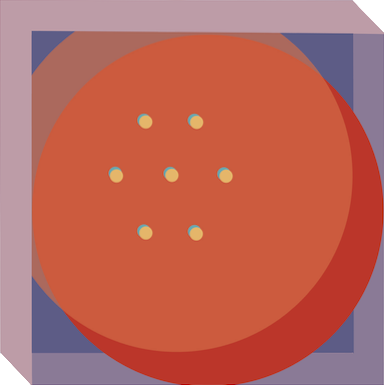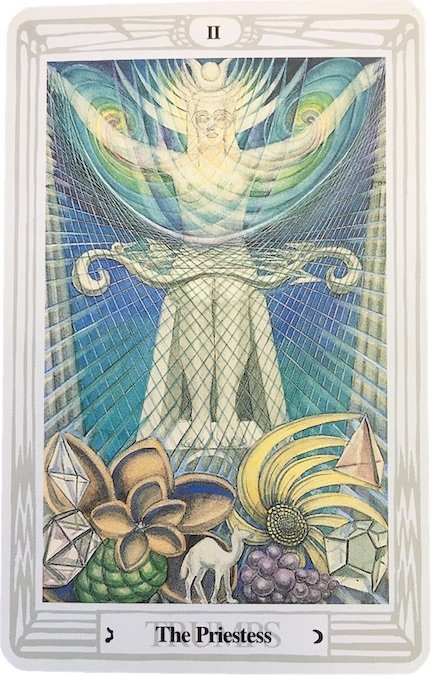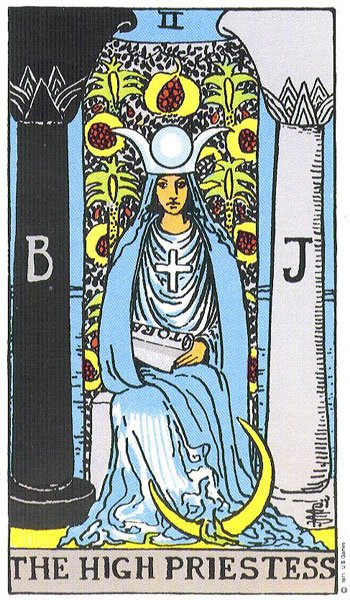THE PRIESTESS : KEY II
The Priestess of the Silver Star
Planetary Trump of the Moon
Hebrew Letter: Gimel (Camel)
Path 13 joining
Sphere 1 – Crown and 6 – Beauty
Purity is to live only to the Highest; and the Highest is All; be thou as Artemis to Pan!
Read thou in the Book of the Law, and break through the veil of the Virgin!
Pure, exalted and gracious influence enters the matter. Hence, change, alternation, increase and decrease, fluctuation.
There is, however, a liability to be led away by enthusiasm; one may become “moon-struck” unless careful balance is maintained.
Alesiter Crowley
The Book of Thoth
The card refers to the Moon. The Moon (being the general feminine symbol, the symbol of the second order corresponding to the Sun as the Yoni does to the Lingam) is universal, and goes from the highest to the lowest. It is a symbol which will recur frequently in these hieroglyphs. But in the earlier Trumps the concern is with Nature above the Abyss; the High Priestess is the first card which connects the Supernal Triad with the Hexad; and her path, as shown in the diagram, makes a direct connection between the Father in his highest aspect, and the Son in his most perfect manifestation. This path is in exact balance in the middle pillar. There is here, therefore, the purest and most exalted conception of the Moon. (At the other end of the scale is Atu 18.)
Mother, moon-maiden, playmate, bride of Pan; God’s Angel-Minister to every man.
The card represents the most spiritual form of Isis the Eternal Virgin; the Artemis of the Greeks. She is clothed only in the luminous veil of light. It is important for high initiation to regard Light not as the perfect manifestation of the Eternal Spirit, but rather as the veil which hides that Spirit. It does so all the more effectively because of its incomparably dazzling brilliance. Thus she is light and the body of light. Upon her knees is the bow of Artemis, which is also a musical instrument, for she is huntress, and hunts by enchantment.
Now, regarding this idea as from behind the Veil of Light, the third Veil of the original Nothing. This light is the menstruum of manifestation, the goddess Nuith, the possibility of Form. This first and most spiritual manifestation of the feminine takes to itself a masculine correlative, by formulating in itself any geometrical point from which to contemplate possibility. This virginal goddess is then potentially the goddess of fertility. She is the idea behind all form; as soon as the influence of the triad descends below the Abyss, there is the completion of concrete idea.

Joan Bunning
The High Priestess is the guardian of the unconscious. She sits in front of the thin veil of unawareness which is all that separates us from our inner landscape. She contains within herself the secrets of these realms and offers us the silent invitation, “Be still and know that I am God.”
The High Priestess is the feminine principle that balances the masculine force of the Magician. The feminine archetype in the tarot is split between the High Priestess and the Empress. The High Priestess is the mysterious unknown that women often represent, especially in cultures that focus on the tangible and known. The Empress represents woman’s role as the crucible of life.
In readings, the High Priestess poses a challenge to you to go deeper – to look beyond the obvious, surface situation to what is hidden and obscure. She also asks you to recall the vastness of your potential and to remember the unlimited possibilities you hold within yourself. The High Priestess can represent a time of waiting and allowing. It is not always necessary to act to achieve your goals. Sometimes they can be realized through a stillness that gives desire a chance to flower within the fullness of time.
THE PRIESTESS’ ACTIONS
STAYING NONACTIVE
allowing events without intervention
being receptive to influence
becoming calm
being passive
waiting patiently
ACCESSING THE UNCONSCIOUS
seeking guidance from within
trusting your inner voice
opening to dreams and the imagination
being aware of a larger reality
SEEING THE POTENTIAL
opening to what could be
seeing your hidden talents
allowing development
letting what is there flower
SENSING THE MYSTERY
approaching a closed off area
opening to the unknown
remembering something important
sensing the secret and hidden
seeking what is concealed
acknowledging the Shadow
THE PRIESTESS’ ROLE IN THE FOOL’S JOURNEY
On setting out, the Fool immediately encounters the Magician (1) and the High Priestess (2) – the great balancing forces that make up the perceived world. It is a feature of the material universe that as soon as we name some aspect of experience, we automatically evoke its opposite.
The Magician is the positive side. He represents the active, masculine power of creative impulse. He is also our conscious awareness. The Magician is the force that allows us to impact the world through a concentration of individual will and power. The High Priestess is the negative side. She is the mysterious unconscious. She provides the fertile ground in which creative events occur. The High Priestess is our unrealized potential waiting for an active principle to bring it to expression.
The terms positive and negative do not imply “good” and “bad.” These are human distinctions that do not apply in the tarot. The Magician and the High Priestess are absolutely equal in value and importance. Each is necessary for balance. We may view the negative as our Shadow, but without shadows, we cannot see the light, and without a ground of potential, we cannot create.
A. E. Waite
The Pictorial Key to the Tarot
She has the lunar crescent at her feet, a horned diadem on her head, with a globe in the middle place, and a large solar cross on her breast. The scroll in her hands is inscribed with the word Tora, signifying the Greater Law, the Secret Law and the second sense of the Word. It is partly covered by her mantle, to shew that some things are implied and some spoken. She is seated between the white and black pillars–J. and B.–of the mystic Temple, and the veil of the Temple is behind her: it is embroidered with palms and pomegranates. The vestments are flowing and gauzy, and the mantle suggests light–a shimmering radiance. She has been called occult Science on the threshold of the Sanctuary of Isis, but she is really the Secret Church, the House which is of God and man. She represents also the Second Marriage of the Prince who is no longer of this world; she is the spiritual Bride and Mother, the daughter of the stars and the Higher Garden of Eden. She is, in fine, the Queen of the borrowed light, but this is the light of all. She is the Moon nourished by the milk of the Supernal Mother.
In a manner, she is also the Supernal Mother herself–that is to say, she is the bright reflection. It is in this sense of reflection that her truest and highest name in bolism is Shekinah–the co-habiting glory. According to Kabalism, there is a Shekinah both above and below. In the superior world it is called Binah, the Supernal Understanding which reflects to the emanations that are beneath. In the lower world it is MaIkuth–that world being, for this purpose, understood as a blessed Kingdom that with which it is made blessed being the Indwelling Glory. Mystically speaking, the Shekinah is the Spiritual Bride of the just man, and when he reads the Law she gives the Divine meaning. There are some respects in which this card is the highest and holiest of the Greater Arcana.


